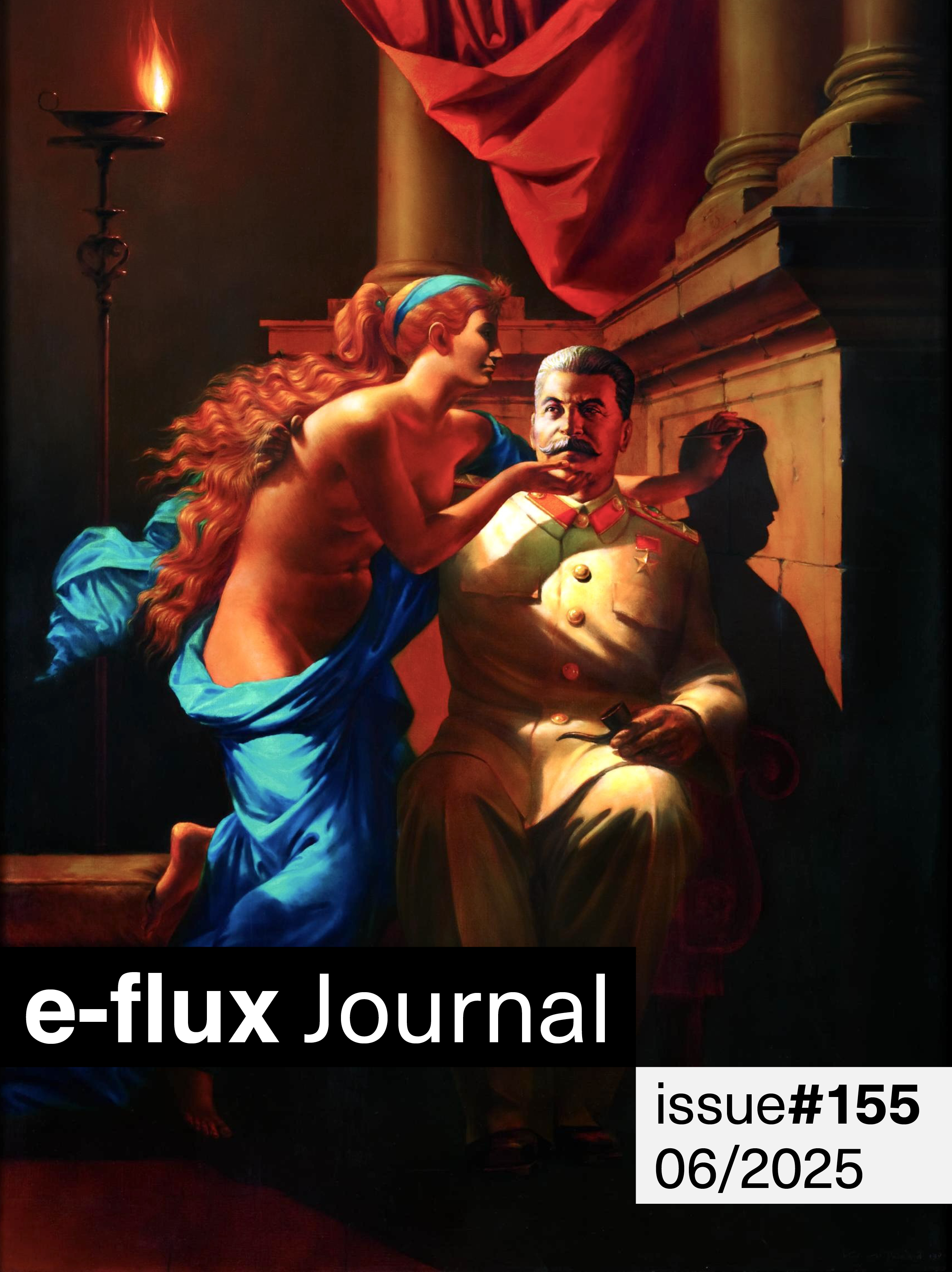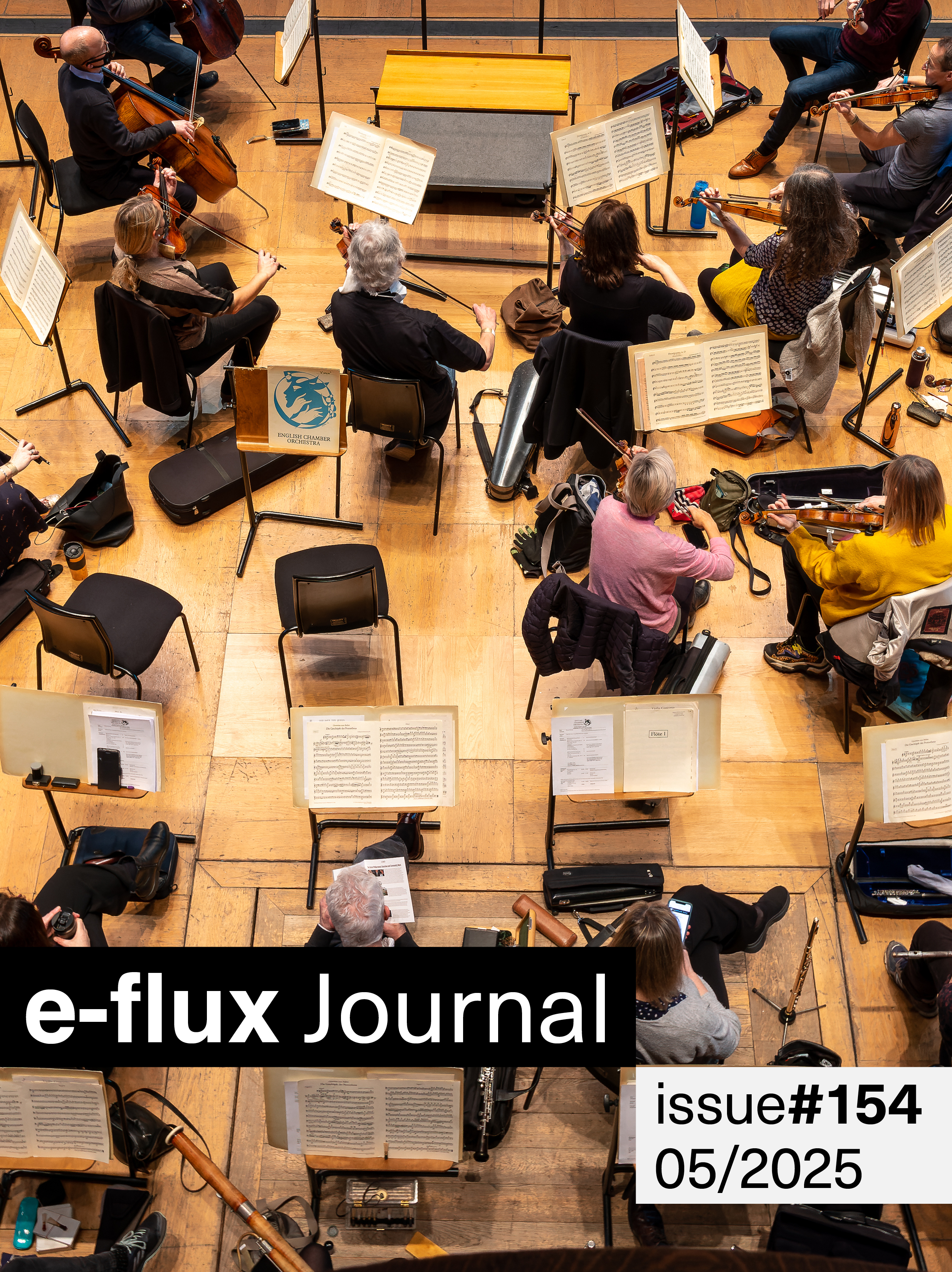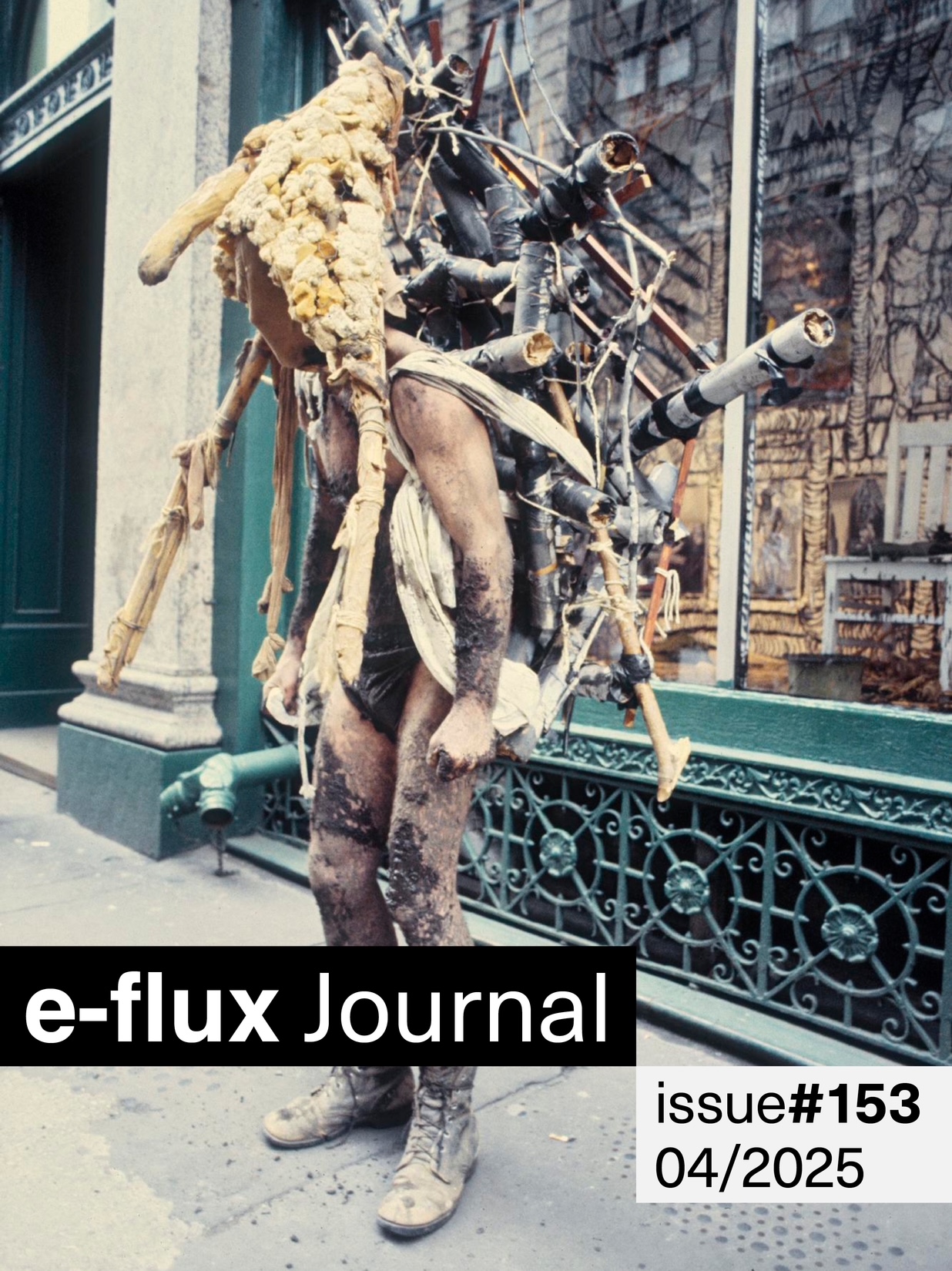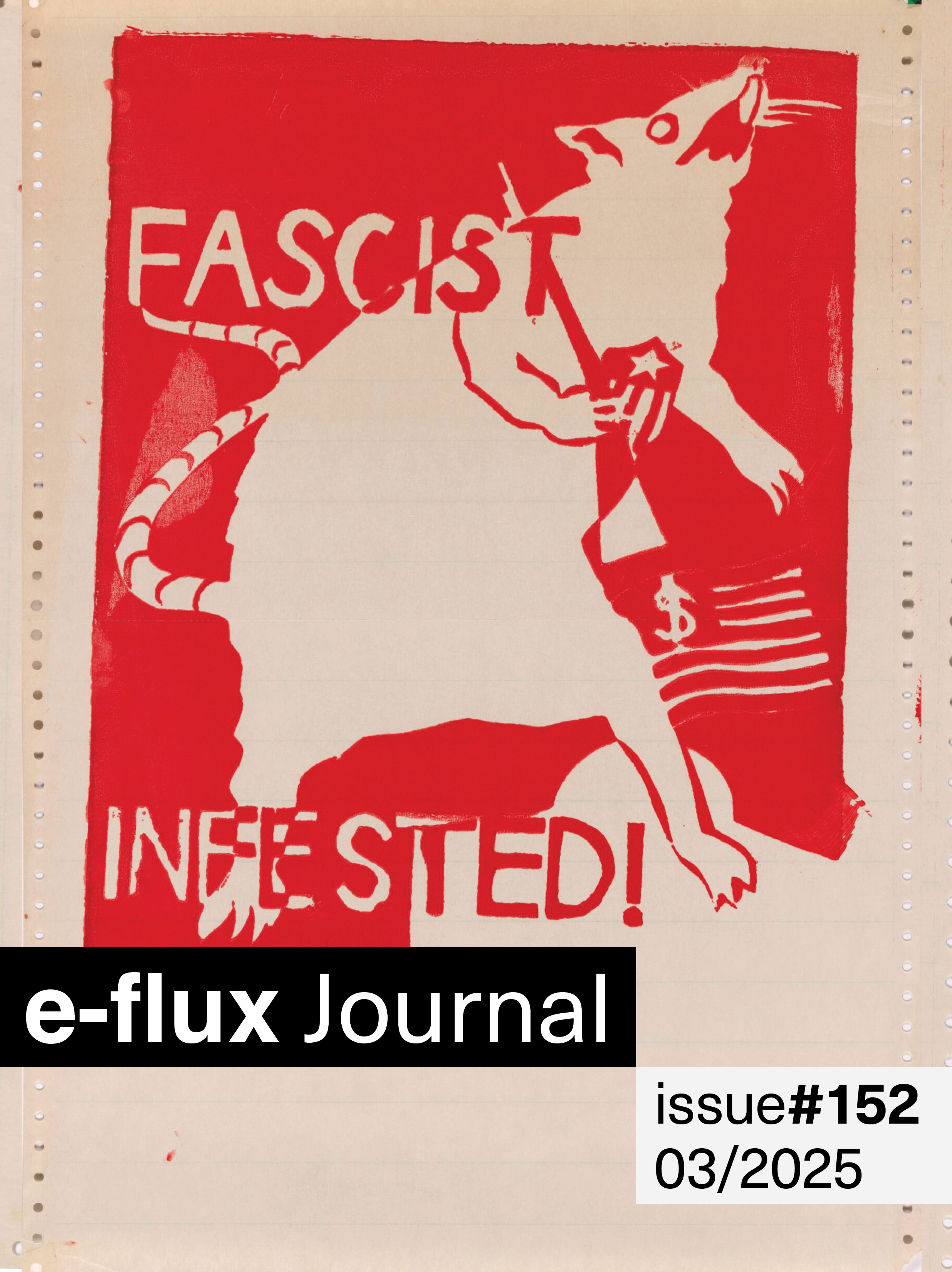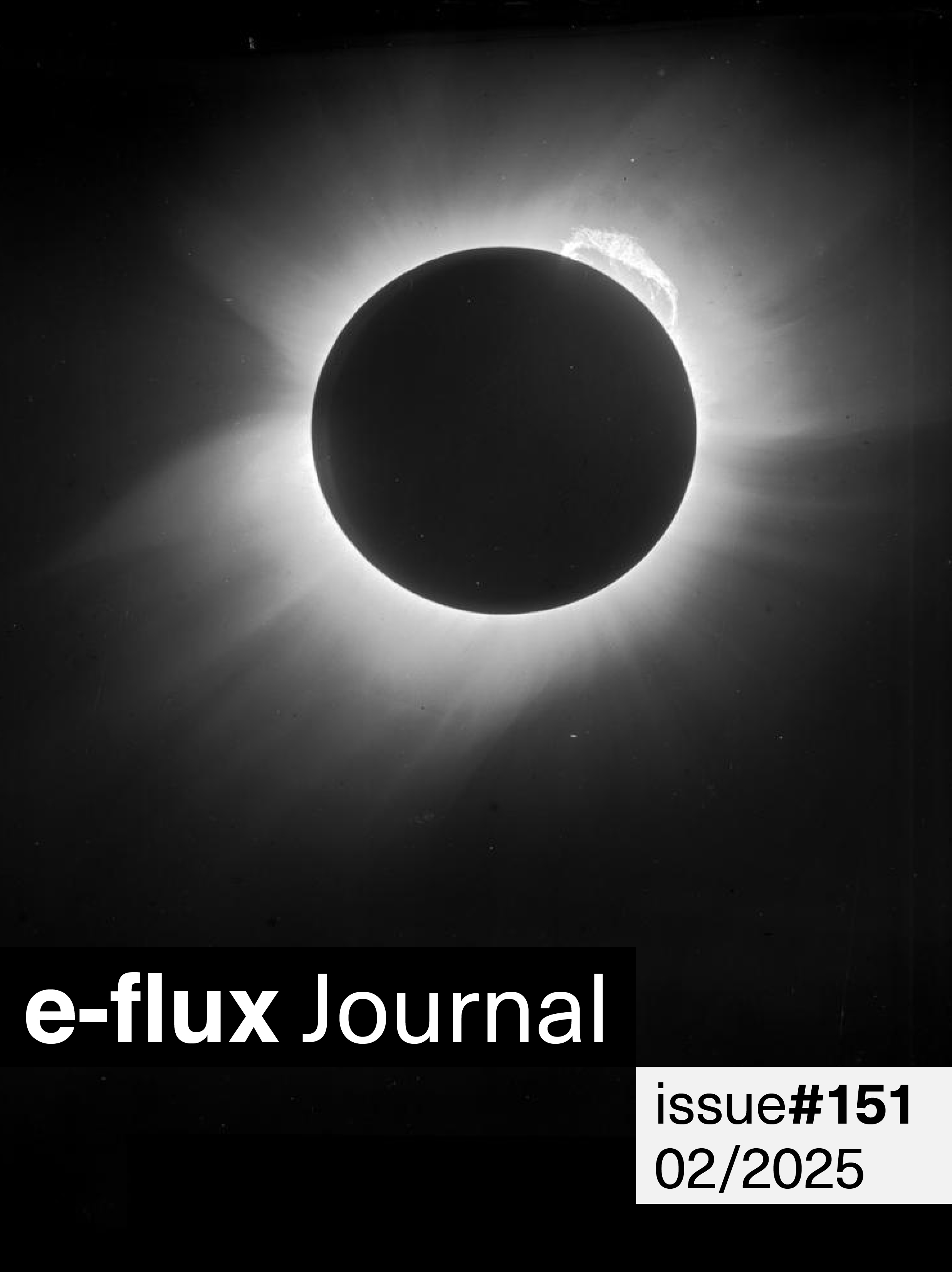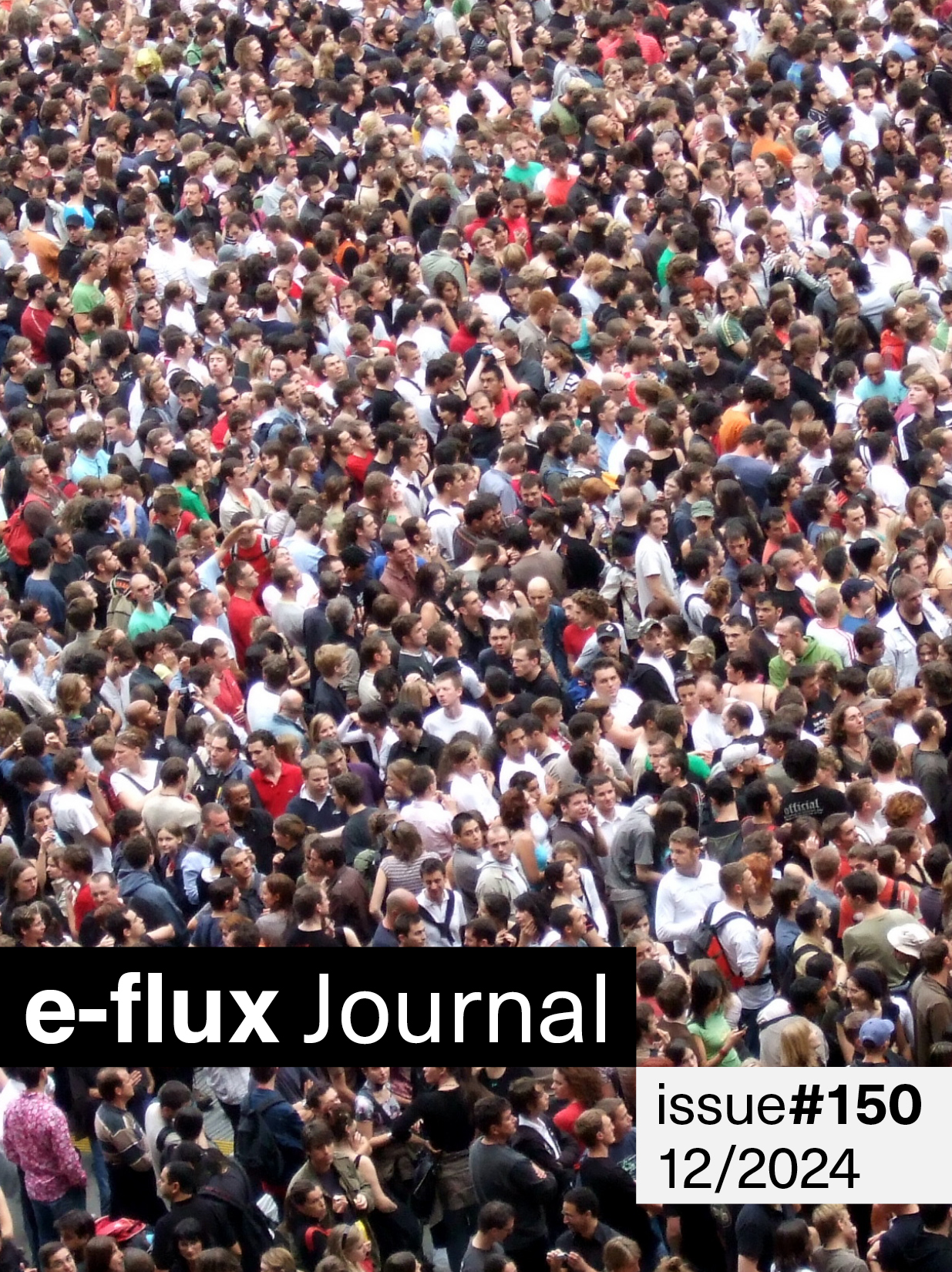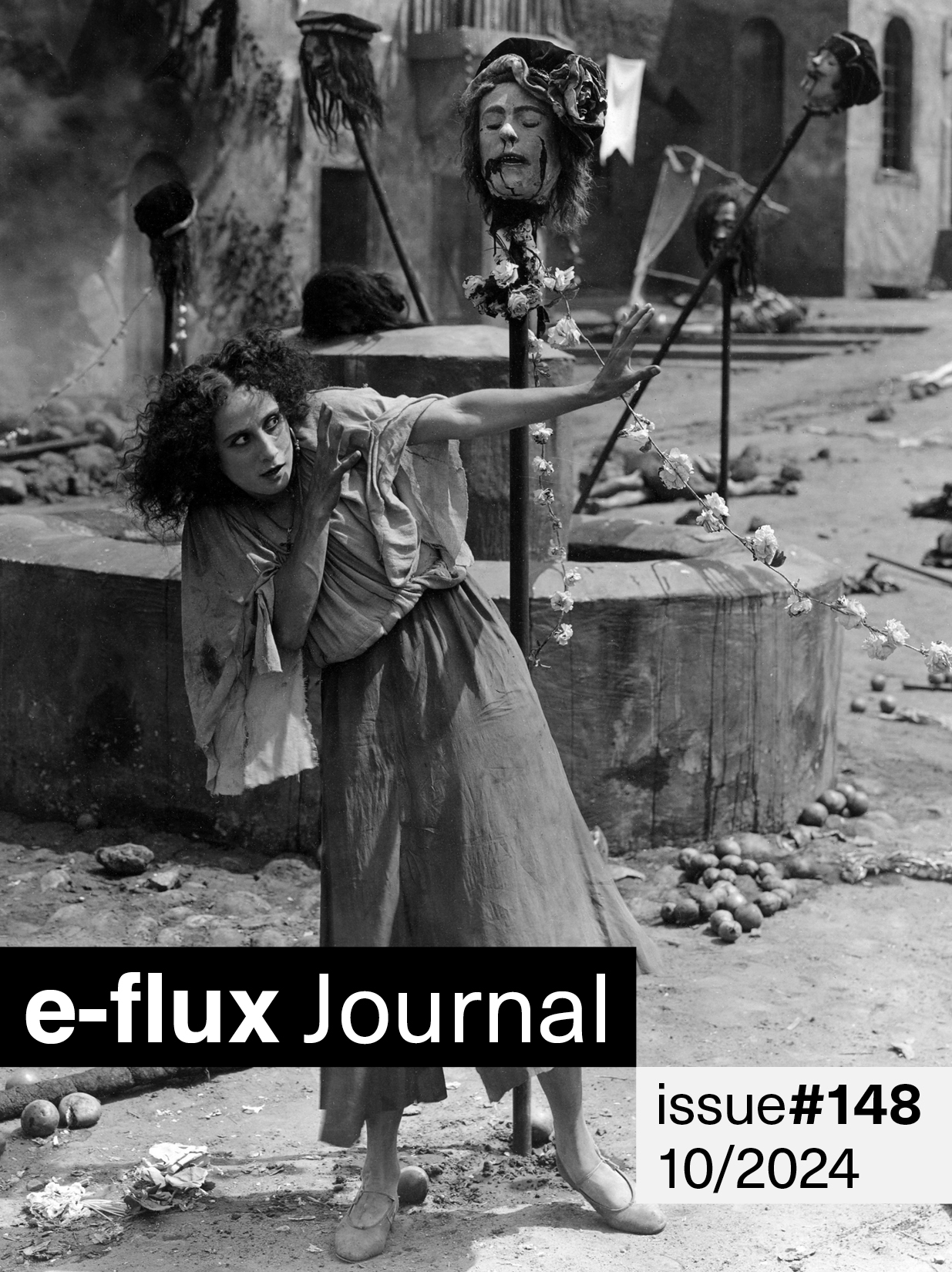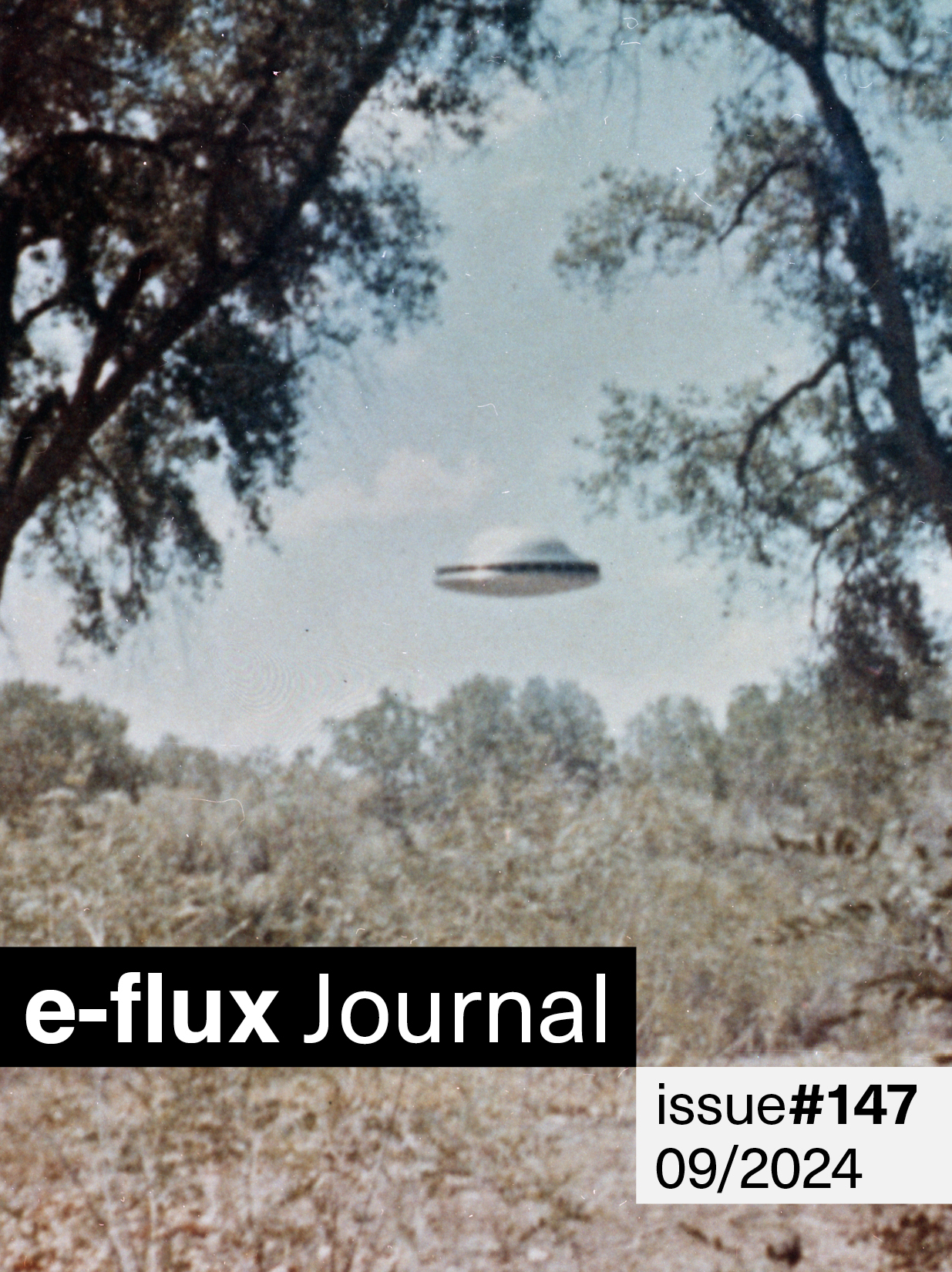e-flux journal issue 50 out now
with Ursula K. Heise, Boris Groys, Shezad Dawood,
Jalal Toufic, Metahaven, and Grant Kester.
Anniversary party: Tuesday, December 17, 9pm
Open bar 9–10pm, with RSVP
China Chalet
47 Broadway
New York, NY 10006
Dear Readers, welcome to the fiftieth issue of e-flux journal. It marks our official five-year anniversary. It’s hard to believe. To celebrate this, we invite all of you who happen to be in New York next Tuesday, December 17, to a party we are organizing at China Chalet. Join us for drinks and music—we will be there from 9pm until the night ends. Please RSVP.
Remember our first issue? Issue #0, November 2008. Thinking back to that moment immediately following the financial crisis of 2007–2008, we realize what a profound shift has taken place in the field of art since then, and how so many of those changes have been reflected in e-flux journal. Yes, many of the changes have been negative and have had intensely destabilizing effects on art institutions and the lives of artists. But at the same time, we can now see how they have meshed with and further radicalized a geographic dispersal in art that had been advancing for some years. It is something we thought about in our first editorial, and in the five years since then, we have witnessed the basic understanding of what art is, and what art is supposed to do, become completely unmoored from any formal or historical narrative.
We have to admit that we are inside an incredibly interesting moment, because, really, when were notions of art fully stabilized if not in the most conservative or idealistic-heroic times? Yes, of course, it would be much easier to return to the grand narratives of the twentieth century, and in many ways we are still completely addicted to a certain voice and mode of address that they produced—the humanistic idealism, the heroic gesturing, the radical ruptures, a certain hostility to the state and to power in the abstract, to fantasies of eternal repose in some modernist fortress, and so forth. Art spaces, artworks, the art market, art publications still reflect the legacy of the twentieth century, which is strange considering how completely embedded contemporary art has been in the very processes that are overwriting these twentieth-century ideals, for better or worse.
The liquidation of infrastructure and the defunding of public support throughout Western Europe and elsewhere has been deeply regrettable, but it has also forced the realization that artists make do with or without structural support, and they never really distinguished between the public sphere and the private sphere in the first place. But maybe it would be better if they did, because what was also fascinating to watch following the crisis was that, rather than a new Arte Povera, we got a booming market together with a slew of museums cropping up in finance-driven or oil-rich cities traditionally known for producing collectors more than artists or art publics. And while the staggering scale of budgets for acquisitions and commissions in these areas of the world are instrumentalizing art and artists in completely new ways, the institutions are themselves subject to an art world that has already assumed the form of a planetary-scale abstraction that totally confounds methodologies for understanding art in terms of formal resemblances or historical continuities. If no formal regime can survive longer than a few minutes, all historical claims are up for grabs; in addition, the careful archiving and conservation of artworks becomes unnecessary or even impossible. Should a national or municipal museum even bother with an art collection anymore? Absolutely—you never know when you’ll need to pawn some art to pay the rent.
At the entrance to the building where e-flux is located in New York, two workers are installing generators in the basement to accommodate the next disaster. Whether bracing for the failure of infrastructure from below ground in the power grid, or from above in the atmosphere, whether due to hurricane or tornado or terrorist attack, we can see the shape of a more pervasive condition: it is not only that we can no longer peg our fortunes to the grid, but that our notions of infrastructure, economy, history, and identity have become increasingly destabilized and even absurd. What happens to art under these circumstances?
Individual people have become more important than institutions. The stabilizing role of art institutions has been transferred to a growing class of professionalized artists, curators, and practitioners who hold the whole thing together. We are severely underqualified and overqualified at the same time, and we like it that way. We are underappreciated and mistreated because, on the one hand, we consider ourselves celebrities, and on the other, we are being used to test cutting-edge labor extraction schemes. But we also know that we can exploit the art world in return by using its bloat to host the burdens and extremely high expectations of so many brilliant people who wasted years gaining PhD-level expertise in political science, programming, journalism, international law, or ethnomusicology. We left those fields for art either because we couldn’t find a job or because we wanted our work in those fields to actually make sense and have an audience or even a public. The art world does not always deliver on its promises, but that is absolutely fine considering that it does better than most governments. And this is probably why it has become a massive refuge for the dispossessed, overambitious, overcreative, undereducated prodigies of the planet to hang out, drink and smoke, and then try to decode the art world’s assigned geopolitical task to navigate through the quagmire of post-infrastructure by identifying the forms that it simultaneously tries to renounce. We are completely inside some interconnected planetary financial-dementia machine defined by interruptions due to weird atmospherics and territorial warfare blending and meshing on a scale that surpasses representation, and we are here to represent it. It is a bit like meta-sculpture or a linguistic, semiotic origami that involves creating names for things that cannot be absorbed by capital flows, even while being absorbed by those very same flows. It sounds exhausting and it is. And that is why we are running on generators, and figuring out ways, as artists and thinkers, to homebrew and store our own energy in our own generators and in each other. What all this points to is information, energy, and vital life forces swirling around to become a new infrastructure defined by completely abstract flows. A certain purifying power that the white cube once commanded has withdrawn behind an economic realism that is totally fine with the sloppiness of the JPEG and the essayistic rant, and everything else that makes up the difference between the lightness of aura and the heaviness of a crate.
It is against this backdrop that so many of the essays published in e-flux journal have been commissioned, written, edited, and published. Art does not produce value so much as consciousness. From all of us at e-flux journal, thank you for reading over these five years, and hope to see you around somewhere very soon.
—Julieta Aranda, Brian Kuan Wood, Anton Vidokle
In this issue:
Ursula K. Heise—From the Blue Planet to Google Earth
If nuclear fear and environmental concern shared narrative patterns, derived in the last instance from biblical apocalypse, a more subtle but no less terrifying vision of global connectedness emerged from fears of corporate conspiracy that had circulated since the 1950s and made themselves explicit in the countercultural resistance to “the Man” or “the System.”
Boris Groys—Entering the Flow: Museum between Archive and Gesamtkunstwerk
However, is it possible for a human being to enter the flow, to get access to its totality? On a certain very banal level the answer is, of course, yes: human bodies are things among other things in the world and, thus, subjected to the same universal flow. They become ill, they age, and they die. However, even if human bodies are subjected to aging, death, and dissolution in the flow of material processes, it does not mean that their inscriptions into cultural archives are also in flow.
Shezad Dawood—Towards the Possible Film (A Script with Some Notable Interruptions)
A brutal group of Cro-Magnons came over the hill and began clubbing Ancient Astronauts to death. The Cro-Magnons were tall, blond, and Aryan; the Astronauts had the blue skin of Krishna and Quetzalcoatl.
Jalal Toufic—If You Prick Us, Do We Not Bleed? No
With my affinity to Shi’ism, I certainly do not need such a demonstration since, irrespective of any wounds suffered in my life (whether as a result of bombardments or otherwise), I already feel even the blood in my veins to be spilled blood, that is, that I am bleeding in my veins.
Metahaven—Captives of the Cloud: Part III: “All Tomorrow’s Clouds”
The possibility for a network—centralized, decentralized, or distributed—to override jurisdiction and state power is a perspective that could be called a proper foundational dream of the internet, as well as a perpetual mirage shaped and inspired by science fiction. New approaches to guaranteeing internet freedoms are increasingly becoming premised on literally eluding these spatial implications of a (perhaps always) reterritorialized internet.
Grant Kester—The Device Laid Bare: On Some Limitations in Current Art Criticism
The most threatening aspect of the exponential growth of participatory and collaborative art practices involves the decision of a growing number of artists and art collectives to deliberately engage publics, and institutional networks, well beyond the confines of the conventional art world. The result has been a series of largely unproductive debates over the epistemological status of this work, most of which entail variations of the same simplistic opposition between a naive social art practice, associated with the evils of humanism or pastoral sentimentality, and a theoretically rigorous, politically sophisticated avant-garde artistic practice.
The print edition of e-flux journal can now be found at:
Amsterdam: De Appel / Rijksakademie van beeldende kunsten Andratx: CCA Andratx Antwerp: M HKA Museum van Hedendaagse Kunst Athens: OMMU Århus: Aarhus Art Building Auckland: split/fountain Austin: Arthouse at the Jones Center Baden-Baden: Staatliche Kunsthalle Baden-Baden Banff: Walter Phillips Gallery, The Banff Centre Barcelona: Arts Santa Monica / MACBA Basel: Kunsthalle Basel, Museum fur Gegenwartskunst Beijing and Guangzhou: Vitamin Creative Space Beirut: 98weeks Belgrade: Cultural Center of Belgrade Bergen: Bergen Kunsthall / Rakett Berlin: b_books / Berliner Künstlerprogramm – DAAD / do you read me? / Haus Der Kulturen der Welt / NBK, Neuer Berliner Kunstverein / Pro qm Berlin and Zurich: Motto Bern: Kunsthalle Bern / Lehrerzimmer Bialystok: Arsenal Gallery Bielefeld: Bielefelder Kunstverein Birmingham: Eastside Projects / Ikon Gallery Bologna: MAMbo – Museo d’Arte Moderna di Bologna Bregenz: Kunsthaus Bregenz Bristol: Arnolfini Brussels: Wiels Bucharest: National Museum of Contemporary Art Bucharest (MNAC) / Pavilion Unicredit Cairo: Contemporary Image Collective (CIC) / Townhouse Gallery Calgary: The New Gallery Cambridge: Wysing Arts Center Castello: Espai d´art contemporani de Castelló (EACC) Chicago: Graham Foundation / Logan Center, University of Chicago / The Renaissance Society Cologne: Kölnischer Kunstverein Copenhagen: Overgaden Derry: CCA Derry~Londonderry Dubai: Traffic Dublin: Dublin City, The Hugh Lane / Project Arts Centre Dusseldorf: Kunstverein für die Rheinlande und Westfalen Eindhoven: Van Abbemuseum Farsta: Konsthall C Frankfurt: Städelschule / Portikus Gdansk: Centrum Sztuki Współczesnej Łaźnia Genève: Centre de la photographie Ghent: S.M.A.K. Giza: Beirut Glasgow: CCA Centre for Contemporary Arts / Sculpture Studios Graz: Grazer Kunstverein / Kunsthaus Graz / para_SITE Gallery Grijon: LABoral Centre for Art and Creative Industries Hamburg: Kunstverein Helsinki: Museum of Contemporary Art Kiasma Hobart: CAST Gallery / INFLIGHT Hong Kong: Asia Art Archive Istanbul: BAS / Cda–Projects / DEPO / SALT Iași:theartstudent at the University of Fine Arts, Iași Innsbruck: Galerie im Taxispalais Johannesburg: Center for Historical Reenactments Kristiansand: SKMU Sørlandet Art Museum Kansas City: La Cucaracha Press Klagenfurt: Press Kunstraum Lakeside Leeds: Pavilion Lisbon: Maumaus, Escola de Artes Visuais / Oporto / Kunsthalle Lissabon Loughborough: Radar, Loughborough University Ljubljana: Moderna Galerija Llandudno: Mostyn London: Architectural Association / Bedford Press / Gasworks / ICA / Serpentine Gallery / The Showroom / Visiting Arts Los Angeles: REDCAT Luxembourg: Casino Luxembourg Madrid: Brumaria / CA2M / Pensart Maastricht: Jan van Eyck Academie Marfa: Ballroom Marfa Melbourne: Monash University Museum of Art / World Food Books Mexico City: Proyectos Monclova Milan: Fondazione Nicola Trussardi, Hangar Bicocca Milton Keynes: Milton Keynes Gallery Minneapolis: Walker Arts Center Moncton: Fixed Cog Hero (a bicycle courier company) Montreal: Canadian Centre for Architecture Moscow: Garage Center for Contemporary Culture Munich: Museum Villa Stuck / Walther Koenig Bookshop, Haus der Kunst Munich New Delhi: Sarai CSDS New York: e-flux / Independent Curators International (ICI) / Printed Matter, Inc Nottingham: Nottingham Contemporary Omaha: Bemis Center for Contemporary Arts Oslo: Kunstnernes hus Oxford: Modern Art Oxford Padona: Fondazione March Paris: castillo/corrales – Section 7 Books / Centre Pompidou / Les Laboratoires d’Aubervilliers Philadelphia: Bodega Pori: Pori Art Museum Porto: Museu de Arte Contemporânea de Serralves Portland: Portland Institute for Contemporary Art (PICA) / Publication Studio Prague: Dox Centre for Contemporary Art Prishtina: Stacion – Center for Contemporary Art Prishtina Providence: AS220 Reykjavik: Reykjavik Art Museum Riga: Kim? Rio de Janeiro: Capacete / A Gentil Carioca Rome: MACRO Museo d’Arte Contemporanea Roma / Opera Rebis Rotterdam: Piet Zwart Institute / Witte de With Saint-Nazaire: Le Grand Cafe, Centre D’art Contemporain Salzburg: Salzburger Kunstverein San Antonio: Artpace São Paulo: Kunsthalle São Paulo / Master in Visual Arts, Faculdade Santa Marcelina Sarajevo: Sarajevo Center for Contemporary Art Seoul: The Books / The Book Society Sherbrooke: Foreman Art Gallery of Bishop’s University Skopje: Press to Exit Project Space Sofia: ICA Sofia / Sofia Art Gallery St Erme Outre et Ramecourt: Performing Arts Forum St Louis: White Flag Projects Stockholm: Bonniers Konsthall / IASPIS / Index / Konstfack, University College of Art, Craft and Design Stuttgart: Württembergischer Kunstverein Stuttgart Sydney: Artspace Tallinn: Kumu Art Museum of Estonia The Hague: Stroom Den Haag Toronto: Art Metropole / Mercer Union / The Power Plant Torun: Centre of Contemporary Art Znaki Czasu in Torun Toowoomba: Raygun Contemporary Art Projects Trieste: Trieste Contemporanea Umeå: Bildmuseet, Umeå University Utrecht: BAK, basis voor actuele kunst / Casco – Office for Art, Design and Theory Vaduz: Kunstmuseum Liechtenstein Valletta: Malta Contemporary Art Foundation Vancouver: ARTSPEAK / Morris and Helen Belkin Art Gallery, University of British Columbia / Fillip / Motto / READ Books, Charles H. Scott Gallery, Emily Carr University of Art and Design Vienna: Salon für Kunstbuch, Belvedere Gallery Vigo: MARCO, Museo de Arte Contemporanea de Vigo Vilnius: Contemporary Art Centre (CAC) Vitoria-Gasteiz: Montehermoso Kulturunea Visby: BAC, Baltic Art Center Warsaw: Zachęta Narodowa Galeria Sztuki / Zachęta National Gallery of Art Wiesbaden: Nassauischer Kunstverein (NKV) Yerevan: Armenian Center for Contemporary Experimental Art, NPAK Zagreb: Galerija Miroslav Kraljevic / Gallery Nova / Institute for Duration, Location and Variables, DeLVe Zurich: Postgraduate Program in Curating, Zürich University of the Arts / Shedhalle / White Space.
